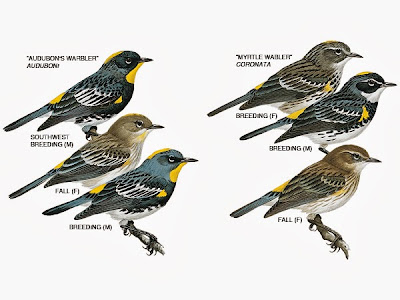Jay, in San Francisco, there’s two field marks that are
excellent, diagnostic clues to help you identify both of these subspecies apart
from one another (see drawings, below).
Let's sort out the "winter" plumages here only, given the obvious differences in appearance for breeding season individuals of both subspecies.
Most (but NOT all) Audubon’s adults during the "winter" wear a faint to solid yellow throat and the
Myrtle always possesses a white throat. In all age classes — from hatch year to
definitive adults — a Myrtle never shows a white throat. That’s the easy, brief
answer.
(Above drawing courtesy of National Geographic.)
But it’s not the full one. That’s because rare to occasional individuals of Audubon's ALSO may express a white throat. Which means it's possible to view a white-throated Yellow-rumped Warbler that could be EITHER the Myrtle or Audubon's subspecies.
So now what do you do for ID?
Use the absence of a faint supercilum (i.e., eyebrow) to
identify Audubon’s (see drawing here) during the non-breeding "winter" season. Noticing the
lack of this feature on a Yellow-rumped Warbler with a white throat should move
you to say: “Bingo, it’s an Audubon’s" (i.e., Audubon's are said to wear a "plain face.)
However, if you see during the non-breeding season both a
faint white supercilum mark and a white throat that reaches around toward the
middle and mid-back region of the neck area on both sides of the head, then
it’s a Myrtle.
In sum, Myrtle Yellow-rumped Warbler shows a faint white
supercilum and a greater amount of white throat surface area than the Audubon’s
subspecies that has a more plain face (lacking the white supercilium mark) and
a smaller white to, more typically, faint to dark yellow throat.
The definitive source for my judgment in this matter consistently remains the Identification Guide to North American Bird, Part 1, by Peter Pyle (Slate Creek Press), which is the bird bander's guide to identification of birds "in the hand," and features field mark information corresponding to all age classes of songbirds.
The definitive source for my judgment in this matter consistently remains the Identification Guide to North American Bird, Part 1, by Peter Pyle (Slate Creek Press), which is the bird bander's guide to identification of birds "in the hand," and features field mark information corresponding to all age classes of songbirds.

9 comments:
Great stuff...Joey Tuttle, Vancouver
But I wonder if you can tell them apart when they sing.....? I cannot, but Dunne & Garrett in "Warblers" field guide say it's possible, especially with call differences between these two subspecies.
Aaron
Now I know! Thanks!
I second the motion: I use the call notes when possible to tell them apart.
Gary Rosen
Yes, calls are OK for iDing these ones, but I still think plumage is a better idea.......Lyle V., Omaha
Nice ......
kate spade handbags
jordan 11
jordan retro
adidas nmd r1
ultra boost 3.0
christian louboutin outlet
retro jordans
moncler
louboutin
retro jordans
supreme sweatshirt
bape
yeezys
pg 1
jordan shoes
moncler outlet
kyrie 6 shoes
lebron james shoes
golden goose superstar
yeezy 500 blush
yeesi339v0
golden goose outlet
golden goose outlet
golden goose outlet
golden goose outlet
golden goose outlet
golden goose outlet
golden goose outlet
golden goose outlet
golden goose outlet
golden goose outlet
Post a Comment